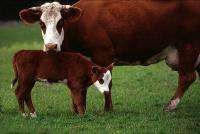Suspected U.S. mad cow case reported

U.S. Department of Agriculture officials say they are investigating what might be the nation's third case of mad cow disease.
A rapid-screening test used on approximately 8,000 dead cattle each week returned the positive result in one animal last week, The Wall Street Journal reported Monday.
Agriculture Department Chief Veterinarian John Clifford issued a weekend statement saying the animal wasn't used to make human food or animal feed but he offered no other details.
Mad cow disease, or bovine spongiform encephalopathy, causes a fatal brain disorder in people who eat infected products from cattle. Department of Agriculture rules require meatpackers to remove tissues that carry the disease -- such as the brain and spinal cord -- from cattle older than 29 months of age.
No cases of the human form of mad cow disease have been linked to the consumption of U.S. beef, the Journal said.
Cattle acquire the disease by eating feed contaminated with the remains of infected animals. Although cattle are natural herbivores, livestock feet in some nations used rendered cattle material as a cheap source of protein.
Copyright 2006 by United Press International
















